Organs are one of the oldest and most complex of all orchestra and band instruments being produced today. Originally, they were built as one of the key features of churches and grand cathedrals, as music was the focal point of many religious services.
Because of their amazing sound quality, depth, and variety, organs have expanded from inside religious settings to almost any music genre imaginable.
With the invention of the circuit board, electronic organs emerged and digital sounds joined the scene. Now, there are over 20 types of organs available in various sizes, brands, complexities, skill level, and budget.
Comprising an entire family of musical instruments, the organ is one of the most versatile to play because it can create sounds like almost any other instrument.
With options for speakers, pedals, keyboards, and extensions, offers the greatest link between traditional settings and sounds and new genres and ways to play the organ.
We considered the components of organs and that the way an organ is assembled and played, along with how much space it takes up, is what determines which type of organ is best for each musician and setting.
In other words, the price, size, and range of sounds are the most important qualities in determining what makes some organs better for churches, others for homes, and still others for touring bands and pop or rock and roll music.
First is knowing how much space and portability you need, then looking at what type of organs produce the sounds you are looking for that match those specifications.
-
 Check on Amazon Search Used
Check on Amazon Search UsedWith options for speakers, pedals, keyboards, and extensions, offers the greatest link between traditional settings and sounds and new genres and ways to play the organ.
-
Pipe, Electronic, & Everything In Between
Whether you are a beginner organist, a church leader, a concert hall manager, or getting ready to tour with your band, we’ll give you details on every type of organ and help you find the best one for your budget, space, sound, and skill level.
Pipe
What Are They?
Pipe organs are the largest instrument in the music world and one of oldest machine designs still being used in the world today. Their grand sound matches their grand styles.
Many were built into churches and cathedrals across America, Europe, and Australia over the past several hundred years that are still standing today.
With metal pipes that can rust, crack, and wear out over time, some of these historic pipe organs are still working like new because they have been well-maintained. Others stand only tribute to the great music they once produced as more and more churches are abandoned and left for ruin.
How Do They Work?
The sound of a pipe organ comes from the wind that moves through long pipes as pressurized air. These pipes are laid out in ranks that the organist controls to make different sounds, tones, and pitches.
The layout for a pipe organ typically includes three to four keyboards with sixty-one notes or keys on each keyboard. Then, a 32 note pedal board accompanies the keys to embellish sounds further.
The last component of control over the sound on a pipe organ comes from a swellbox, which may or may not be included on each pipe organ.
Where Are They Most Popular?
Even holding the most traditional sound any organ can make, pipe organs are popular for several types of music and modern events.
Religious settings may be the most obvious place to expect a pipe organ, but it is common to have them orchestra halls, recitals, rock concerts, and even sometimes private homes.
In order to bring this epic sound to such a varied list of venues, several sizes and designs of pipe organs evolved over the years.
Varying from cathedral to home size, style, sound volume, price, and skill level, pipe organs create immaculate sound for environments as small and intimate as homes and as public as cathedral-style churches.
With this many options and types of traditional pipe organs, it is hard to believe that electronic organs are the most popular on the market today. Bands like Yes, Styx, and Arcade Fire have even used old school pipe organs in mainstream media recently.
Either way, the original sound produced by physical organ pipes is one of a kind, and whether you need to fill a large or small space, there is bound to be an instrument that will look, sound, feel, and play the volume you need to fill.
Chamber
One type of pipe organ is the Chamber organ. As one of the smallest organ designs, only one manual and a lack of separate pipe pedals characterize this miniature organ. In turn, the repertoire is also restricted as far as what sounds, styles, and effects you can play on this instrument.
There are also fewer stops built-in so the sound is shorter, an appropriate adjustment for an instrument being played in a smaller space closer to individuals eardrums.
Here’s a sample of this type of instrument being played at several tempos:
As you can see in the video, with a smaller size this instrument is meant for small rooms or chambers in homes, small meeting rooms, and churches and can be easily moved across a floor space.
The full sound is meant to echo off of the walls in these closed spaces creating an ambient effect. With little to no confusing advanced features to learn the chamber organ is a great piece for beginners.
Despite the complicated nature of the organ itself, this version will not hold you back over complex technology to understand or expensive accessories to set up.
With this simplified organ, you can start learning the keys, notes, and basics without feeling overwhelmed by new market features or special effects.
Church
While many types of organs on the market today are specifically called “church organs,” there are a wide variety of instruments that fall under this category.
Based on the size of the church, the size of the congregation, the skill level of the organist, and the church budget, a church may choose a large, small, built-in, or portable organ. These church organs can be traditional pipe organs, digital organs, or hybrids
One key feature of church organs is that they sound impeccable with many types of vocals including congregations, choir, and soloists. This is why some rock and roll bands or other contemporary musicians may choose to use them outside of churches for other genres of music
Ten designs from one of the most popular church organ manufacturers can be found on their website. In order to get a price, you contact the company, Allen, and they connect you with a local representative. Then, this person helps you get the organ professionally installed.
Theatre
The theatre organ was originally designed for accompaniment to silent movies. An organ would sit in the back of a movie theatre, and an organist would play during the film.
Because they are compact and simpler to play than grand cathedral-style pipe organs, they became popular for many genres. On the other hand, they offer a wide variety of sounds that also make them adaptable to many different types of music.
Specifically, theatre organs were designed to include so many sounds that it imitates that of an entire orchestra. They feature extra sounds like those of percussion and other special effects.
They have fewer pipes than standard organs, but still use traditional pipes, another unique feature of this member of the organ family. Rather than using as many pipes as other pipe organs,
Rather than using as many pipes as other pipe organs, theatre organs use high wind pressure and a unique feature called extension to make loud sounds and different tones and pitches.
Bamboo Pipe
Although not a practical option for everyday organ players, some of the most unique pipe organs on the planet are made out of alternative materials.
One particular type, a bamboo organ, has now made an appearance on scene in both a traditional church setting and a modern concert design in the past 200 years.
The first bamboo organ has been restored at least once since its construction and can still be played if you travel all the way to the Philippines. A priest built it inside St. Joseph’s Church in 1824 and it has remained standing ever since.
There is even an entire music festival titled after it that centers around the instrument once a year.
Another modern artist is creating instruments similar to organs out of bamboo. Their pipes and airflow mimic organ designs, although more complex in assembly and horizontal in lay out. His website was not available in English, but the pictures alone are worth checking out!
Reed
Reed organs can also be called pump organs or harmoniums. The sound from a reed organ comes from reeds like in a piano accordion.
Reasons to choose a reed organ are that they are simpler than pipe organs and offer more flexibility in usage. They are smaller and therefore more portable, so that make them better for spaces that are used in various ways, like church reception halls.
They are also cheaper because they require fewer materials to make than the grand pipe organs. On the other hand, the sound quality of a reed organ is also much smaller and limited than that of a full pipe organ.
With only one or two manuals, reed organs often skip pedalboards completely. Sounds samples of this type of organ are available online.
Ultimately, these are smaller and simpler organs that still contain many complex parts and require a high level of skill to play, with more flexibility about where they can be placed and who can afford them.
Chord
Another type of smaller organ, chord organs have left handed chord buttons that look very similar to the left-handed component of an accordion. They were briefly popular before electronic organs began selling.
Considered more of a vintage item, chord organs do not offer nearly as many sounds like any other type of organ or even as some keyboards. They are, therefore, not available in popular music stores today, but through as simple google search,
I was able to find many on sites like Etsy, EBay, and other local music store sites. They come in many different styles, and colors, and range from the lower end of twenty to forty dollars in price to the high end of about two hundred dollars.
For someone who wants to create an organ sound without learning a complex instrument or having a large piece of equipment, chord organs could be your wacky solution.
Steam
A steam organ creates sound very similarly to pipe organs but uses steam rather than air to create wind. It is also called a calliope and is usually designed on wheels and intended for outdoor use.
This video, filmed on a river in New Orleans, LA, shows a boat that hosts a steam organ being played. If you listen carefully, you can hear the particularly whistle like qualities in the sound created by the air.
An antique piece of river town music history, steam organs can also be heard sometime in old-timey cartoons and jazz settings.
Electronic
After discussing so many types of organs that create sound through manually maneuvered devices, we finally arrive at the electric organ! These are much smaller and lighter because they have zero heavy, spacious, and expensive pipes.
The invention of the electric organ almost totally replaced the reed organ and allowed organ music to be accessible in venues and for budgets much smaller than the traditional instruments allowed for.
Electric organs are also more affordable and portable so that beginners and new settings can use organ music rather than just the traditional settings.
Hammond
The Hammond Organ was the first electronic organ. There are two main models of Hammond organs: one is the console model and the other the spinet model. More advanced, complex, and elaborate, the console versions are closer in model to the original nonelectric organs.
The spinet model is an all in one organ because it includes the amplifier and speaker. It also is more compact as it holds a smaller keyboard than full sized electronic organs. This keyboard has only 44 keys and fewer pedals correspondingly.
Made for portability, the spinet version allows Hammond organ users to have a larger stationary version or a smaller traditional version.
Hammond organs are some of the most widely used organs in the mainstream media and music production. They became popular in soul jazz and gospel, the building blocks of rock and roll.
Eventually an important sound rock and roll, Hammond organs were used by Santana and Deep Purple, among many other legendary bands. The B3 model is especially popular in jazz music, as it can substitute bass and piano sounds. It was even called “the king of instruments.”
Frequency Divider
Frequency divider organs use oscillators to create sound, which is their main differentiating feature. This allows them to bend pitch and offer a unique way to create sound.
They are more affordable and more portable than pipe organs and even some electronic organs, but not easily found on the market today.
Combo
The combo organ is one of the most popular organs in the organ family. It emerged on the market with the invention of the electronic organ and created the dominant sound in 60’s and 70’s pop music.
Combo bands are groups with combinations of brass, string, percussion, and vocalists. They are typically small in group, with less than half a dozen members, and historically have played small venues, at bars and weddings, and on tours across the country.
So, this small instrument with a versatile sound that can be easily moved and matched to other instruments eventually became known as the combo organ.
Basically, a combo organ is a hybrid organ, meaning it makes sounds with some pipes, some sounds with digital samples, and uses electronic circuits to program all of the sounds to the keys, nobs, and pedals.
Later used by bands like The Doors and Iron Butterfly, this type of organ has been on stage at events of all types. They are now available in many brands both new and used, with some of the most popular being Yamahas and Rolands.
Digital
The digital organ was made possible by the invention of the integrated circuit. It creates sound with additive synthesis, sampling technology, and physical modeling synthesis.
These complex computer software and hardware inventions have allowed musicians to sample from databases and collections of sound, implementing them in new works and new ways.
This instrument represents the intersection of technology and musicality and the endless possibilities we can create when we combine the two.
Virtual Pipe
Technically, virtual pipe organs are a type of electronic organs. They do not have seats, keyboards, speaker boxes or pedals at all.
Instead, they access a database of recorded samples of actual pipe organs, then allow musicians to play via a touch screen on a small computer or tablet.
The pedals, stops, expression, bass, and a full combination system are part of this computer program, not physical pieces of a complex instrument. What Amazon’s Kindle has done for books, virtual pipe organs have done in the music scene.
For sale by many new tech companies and music groups, a virtual pipe organ is a great way to learn the basics of playing the organ before investing the time, space, and money of buying an entire physical organ.
You can even try out what it is like to play a virtual pipe organ on the Hauptwerk website with their online virtual experience.
Our Recommendations
The most practical, median-sized, and high-quality sound organ is hard to determine, so instead, we have chosen the console organ as our best all around, and then given specific recommendations for beginners, churches, touring musicians, and concert halls.
The Best All-Around: The Console Organ

Credit: Hammond USA
For the most versatile, adaptable, median-budget organ, I have selected the Hammond console organ. With options for speakers, pedals, keyboards, and extensions, it offers the greatest link between traditional settings and sounds and new genres and ways to experience and play an organ.
With options for speakers, pedals, keyboards, and extensions, offers the greatest link between traditional settings and sounds and new genres and ways to play the organ.
For the best selection of console organs, visit this page on the Hammond website. Here, you can view and read about five newly designed models that are meant to recreate the best organs in history based on their best qualities.
For example, a “praise and worship organ” boast of the ability to match hymns or contemporary music. The A-162 is modeled after a popular 60s organ that is compact and budget-friendly, making it a great model for homes and smaller event spaces or concert halls.
The C3 model is a beautiful instrument that is equally, if not more popular than the B3 model.
By utilizing electronic inventions like the circuit board, organ designers have been able to build instruments almost as small as traditional pianos that can offer many of the features of traditional pipe organs.
The evolution of this instrument has prompted an entire family of organs to join the music scene. This gives organ players a wide variety of choices and opportunities for the music they make, space they play in, and budget they manage.
Without a doubt, there is some type of organ out there that will be a perfect match for literally anyone who wants to start playing. With a little time exploring these links and checking out all the types of organs available today, you will be playing the most complex and oldest instrument out there in no time.
For Beginners: Hauptwerk Virtual Pipe Organ

Credit: Milan Digital Audio LLC
After researching over 50 types and brands of organs, I strongly believe the best first step in finding the right instrument is to buy a software program like the Hauptwerk Virtual Pipe Organ.
Best for Beginners
This software will give you the chance to learn the ropes of playing an organ, allow you to sample different sounds and types of organ music, and sample different ways of playing without having to learn the entire techniques required to manually work a full-sized organ.
This program will in no way substitute for the epic sounds a full organ can create at your fingertips, but it will help you know exactly what type to look for and how much money you need to budget.
On the Hauptwerk site page, you can click each virtual program to learn about the original organ that each program’s sound was recorded from. In other words, each specific program on the site offers sounds from a real pipe organ that stands in a cathedral or church.
Many of the organs used by this company are of the oldest and most advanced pipe organs in Europe, so the sound created from a simple computer screen is hardly simple.
For Churches: Rudy Lucente Design

Credit: Allen Organ Company LLC
One of the great church organs from Allen Organs is called the Rudy Lucente Design. It was created by the Catholic career organist and is known to be one of the most versatile and comprehensive organ designs for churches yet.
It is intended for congregational hymns as well as concerts. Listed on the site as one of the company’s custom design organs, expect to pay top dollar and receive unmatchable sound quality from the Rudy Lucente Design with Allen Organs.
For Touring Musicians: The Portable B3 Hammond

Credit: Hammond USA
Modeled after the most popular organ used today, this version of the Hammond is portable and made specifically for touring musicians who need easy setup and take down without compromising the safety and sound quality of their instrument.
Unlike spinet models of the Hammond, this particular model comes complete with all 61 keys on each of its two keyboards and a 25 note pedal board.
With 12 preset keys and an internal memory card, it truly combines the best of traditional, manually played organs, electronic organs, and portable versions.
Armed with LCD display, percussions, full polyphony, a Leslie switch, two swell drawbars, two great drawbars, and two pedal drawbars, this Hammond organ somehow weighs less than 300 sounds and packs incredible sound potential.
If you have the budget to buy a new instrument, this one is the way to go. You can find many other Hammonds online on sites like eBay, amazon, and musicians’ friend.
Available both new and used, there will definitely be an instrument fit to your requirements. This portable B3 Hammond, however, offers about every perk in the book with a professional look and expert sound.
For Concert Halls: Allen Organs

Credit: Allen Organ Company LLC
Allen Organs offers several top-of-the-line theatre organs. They are created to imitate the traditional pipe organ sounds as closely as possibly, designed by world-renowned musicians, and use digital technology to keep the design compact yet sounding of quality.
With two, three, four, and five manual options, this organ is a great pick for someone who is of beginner level and wants to slowly introduce newer features or experts who are ready for more advanced instruments.
The Chord Organ
While this model will not be a practical solution for most serious musicians, the chord organ is just too simple and straightforward looking to ignore.
For individuals who play accordion or keyboard, this will be a natural instrument and next step in your music abilities.
My favorite for sale online now was found on eBay in Greece, comes in a bright orange color true to its decade, and boasts of being made somewhere between 1970 – 1980. The lightweight design and small size, not to mention the price of lower than fifty dollars, make this a tempting addition to any keys players’ repertoire.
With options for speakers, pedals, keyboards, and extensions, offers the greatest link between traditional settings and sounds and new genres and ways to play the organ.
Best for Beginners
Sources
- Organ (music), Wikipedia, December 8, 2016. https://en.wikipedia.org/wiki/Organ_(music)
- User “Serflac,” Bamboo Organ. Atlas Obscura, December 8, 2016. http://www.atlasobscura.com/places/bamboo-organ-church
- User: “eindelikgevonden,” (November 10, 2015). Testing Positive Chamber Pipe Organ. Youtube. December 10, 2016. https://www.youtube.com/watch?v=pWp8Q7CHRLQ
- Hauptwerk Virtual Pipe Organs, Features. Milan Digital Audio, LLC. December 10, 2016
- User: “MrAwesomer,” May 15, 2012. Riverboat Natchez Steam Organ. Youtube. December 10, 2016. https://www.youtube.com/watch?v=XEDNXNEmLj4

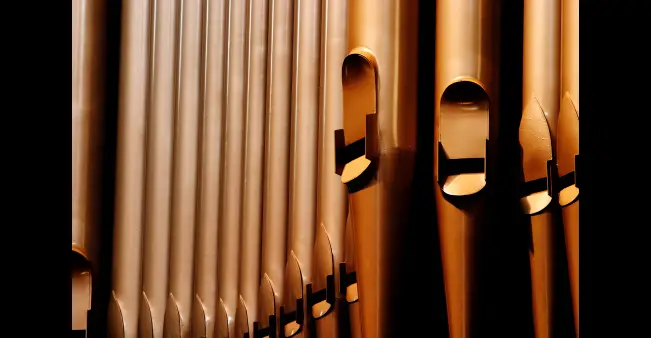



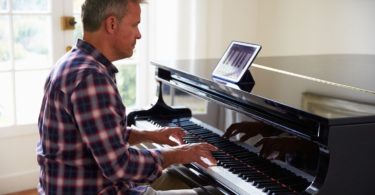

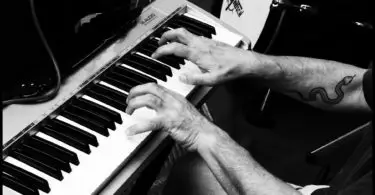
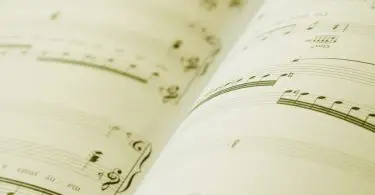

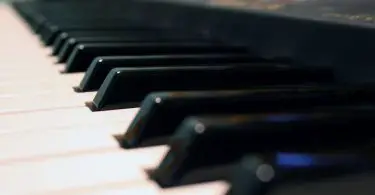
Start the discussion at talk.hearthemusicplay.com